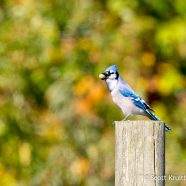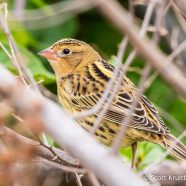Blue Jay Caching
If this Blue Jay (Cyanocitta cristata) looks a little strange…or lumpy…it is because it was hard at work caching last month. All of those acorns will not store (or plant) themselves! They are said to be able to carry five acorns at a time and store several thousand over a productive fall season. I wonder how many it will be able to remember come winter, and how many will be left after squirrels, chipmunks, other rodents or birds take their share… Scott Kruitbosch Conservation & Outreach Coordinator
Read MoreStill Not Spring
It is not spring even though many Clouded and Orange Sulphur butterflies continue flying and feeding on nectar sources like this dandelion. Something that gives away the relative date of this photo is the low sun angle adding light from the side as we are less than two months from the winter solstice. You can also see a little bee mimic fly venturing into the flower, too.
Read MoreRed-banded Hairstreak
Here is one very close view of a beautiful Red-banded Hairstreak (Calycopis cecrops) from last month. The little butterflies are disappearing now that we are into October, and they will be missed. Until next year…
Read MorePine Warbler
Here is a Pine Warbler (Setophaga pinus) that I enjoying finding last weekend during less than optimal migratory conditions on one of those autumn days that feels like the definition of the seasonal transition. And would you look at that, what is it foraging in? Why a White Pine tree, naturally. They are also one of the first warblers to return in the spring when March is finally beginning to break winter’s hold on the Northeast. Pines are a bright little beacon of spring’s light coming in or summer’s glow heading out. We only have a few more weeks to enjoy a variety of...
Read MoreFall Bobolink
This Bobolink (Dolichonyx oryzivorus) was a beautiful sight for the first day of October as it fed on seeds with sparrows, especially once it allowed this great a look. Keep an eye on your fields, grasslands, gardens and farms for more birds like this one still heading out and other new migrant species – like the Vesper Sparrow – arriving soon.
Read More








